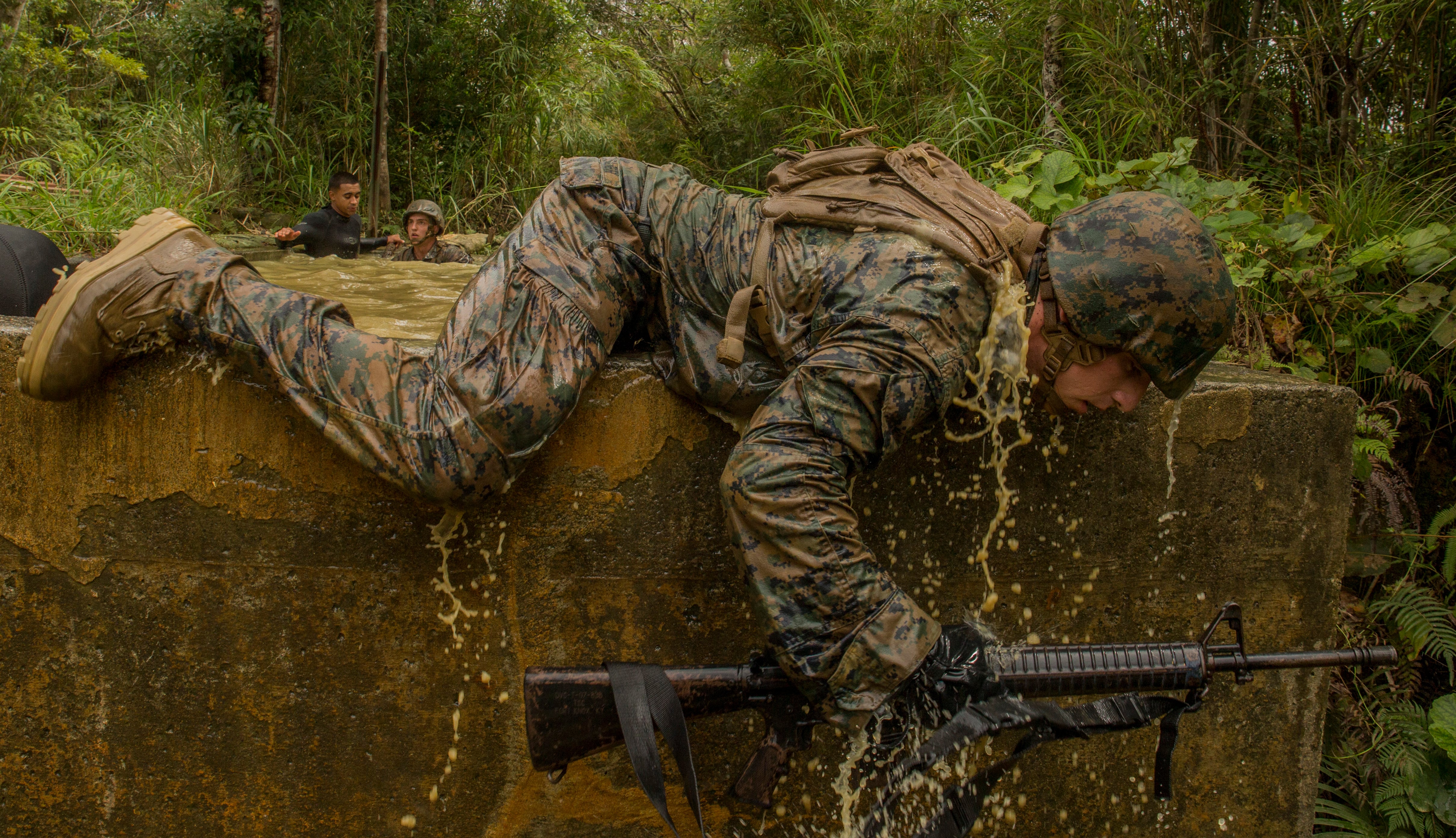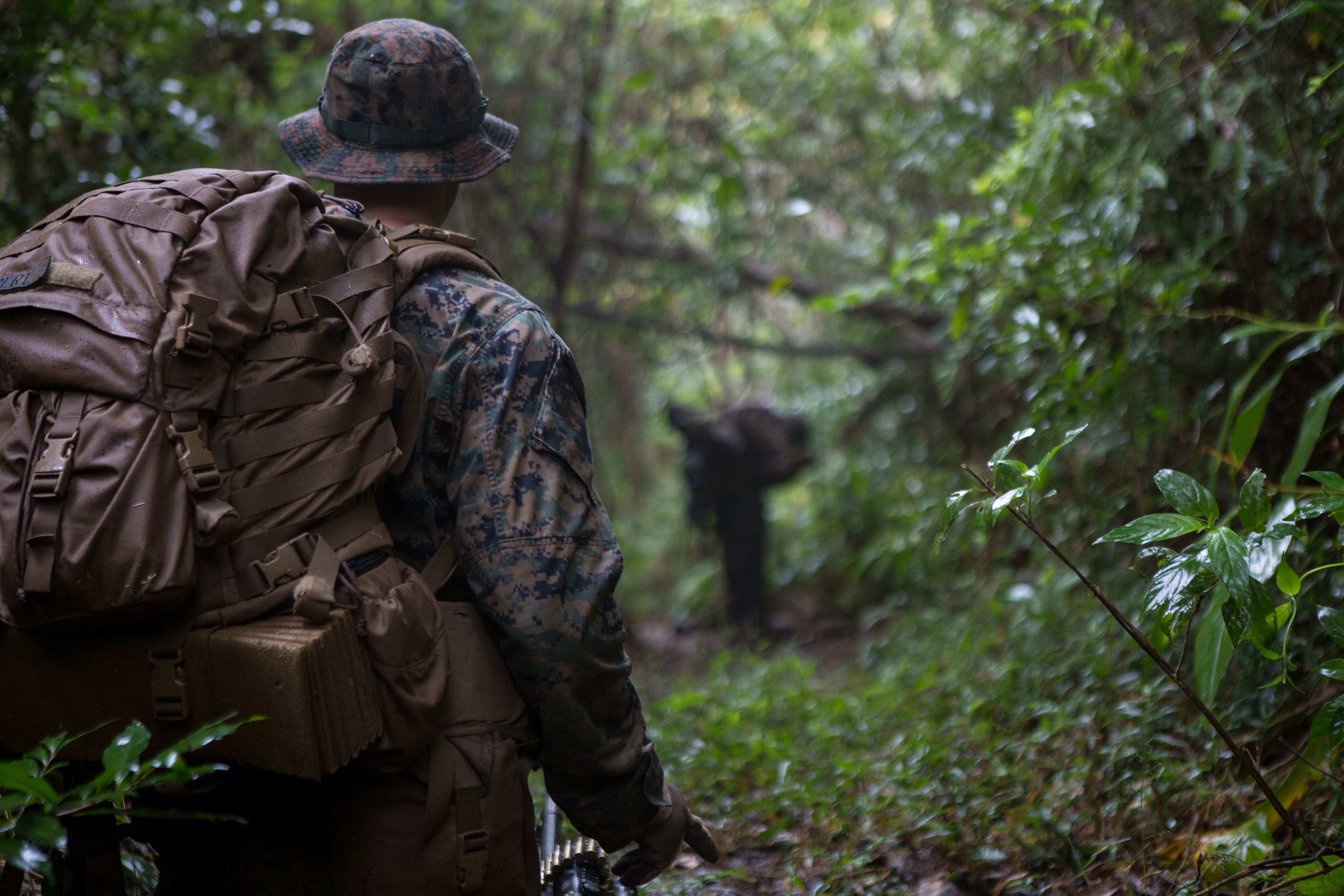Marines in Japan will put new tropical uniforms and boots through the rigors this summer as they trudge through double-canopy jungles and murky waterways in peak humidity.Tropical boots aren’t the only item service officials look to improve for Pacific-based Marines. Marine Corps Systems Command has also teamed with Army Contracting Command to find a lighter and more breathable combat utility uniform — and Marines will put the first batch to the test this summer.
As Marines' deployments to tropical locales heat up, the Corps is on the hunt for lightweight, breathable boots and utes that dry quickly in rainy, humid climates. About Roughly 400 leathernecks Marines from the Hawaii-based 3rd Marine Regiment will wear the tropical uniform prototype along with four pairs of different combat boots for a three-week wear test at the Jungle Warfare Training Center in Japan. The three-week wear test will include prototype uniforms designed specifically for the Pacific’s hot tropical climates.
Lt. Col. Rob Bailey, product manager for infantry combat equipment at Marine Corps Systems Command, said the wear tests will be conducted during scheduled training. Marines at the Jungle Warfare Training Center rappel from steep cliffs, carry mock casualties through fields of mud, trek through brown waters, cross rope bridges and complete endurance courses — all while the jungle canopy sends humidity levels soaring.
"The limited user evaluation will be conducted concurrently with scheduled training at the Jungle Warfare Training Center," said "The operationally realistic training in a challenging environment will provide good feedback on the effectiveness, durability and other characteristics of the boots, and will help to inform the development of performance specifications," Bailey said.
Tropical utility uniforms
ReadyOne, a military garment manufacturer based in El Paso, Texas, provided the uniforms for the wear test. The company used various combinations of nine materials for different utility uniforms. Marines will test them all to determine which is lightest, quickest to dry, and able to withstand the rigors of jungle operations.
The Marine Corps teamed with the Army when asking services asked companies industry to identify a lighter tropical uniform fabric that improves moisture management and reduces dry time without sacrificing durability and protection. The tropical utilities will have permethrin treatments that helps repel insects before they are issued, which typically last for 50 washings. Officials also looking into flame resistance treatment.
Don’t expect to see tiger stripes or some cool new jungle camouflage pattern, though. The idea is to keep the same colors and patterns as current uniforms in woodland Marine pattern. The difference will be in the material.

Cpl. Kevin Kusler crawls over a stone wall during the jungle endurance course at Camp Gonsalves, Japan. Marines training at the Corps' jungle warfare center will test new tropical lightweight uniforms and boots this summer.
Photo Credit: Lance Cpl. Diamond Peden/Marine Corps
ReadyOne, a military garment manufacturer based in El Paso, Texas, provided the uniforms. The company used various combinations of nine materials to identify the best solution — one that will be lighter to carry, quicker to dry, and able to withstand the rigors of jungle operations.
ReadyOne's materials range from standard to newer developments and include nylon, a fire-resistant cotton, cotton/nylon rip-stop fibers, a polytetrafluoroethylene PTFE blend, and a polyester mix, said Pat O’Connor, a company spokesman. Officials were provided 150 units of each of the nine materials, he said, and have since asked for "a couple hundred more of certain materials," though he could not elaborate.
The materials were also used to create variations of Army combat shirts to be worn as part of the evaluation, O'Connor said.
Quick-drying boots
Good footwear in tropical environments is crucial. Trench foot or jungle rot disease can turn serious fast if gone left untreated.
The Marine Corps bought 100 pairs of each of the four jungle boot prototype from four vendors: Original Footwear, Bates Footwear, Belleville Boot Company, and Rocky Boots. The Marines participating in the wear test will provide written after-action surveys, and MARCORSYSCOM officials systems command will conduct close inspections to gauge the quality of each boot.
Commandant Gen. Robert Neller has pushed for a better boot in December, and the Corps soon joined forces with Army contractors, who have been working the issue for nearly two years.
Both the Marine Corps and Army wanted lighter boots that dry faster than the current combat boot. The call for prototypes stated that the boots' length could range from 6 to 9 inches. Ankle support will be carefully monitored, and it must be easy to remove mud and other debris, officials said. The goal is a pair of boots that weigh 1.7 pounds; the threshold is 2.3 pounds.
Bates Footwear supplied the services with a water-resistant Wolverine Warrior Leather boot, said according to Julie McCauley, the company's marketing manager. The boots feature a multichannel design with drainage ports and anti-microbial lining. They weigh 1.6 pounds each.
Belleville Boot Company couched its submission as a modern version of the Vietnam-era jungle boot. A waterproof combination of breathable 1000 Denier nylon and flesh-out leather sits atop a high-traction rubber VIBRAM Panama II outsole, said Glen Becker, chief sales officer. Components are connected by double and triple stitched seams for enhanced durability. Two drainage perforations aid in dry time. Unlike the jungle boots of old, this is centered on a highly cushioned, shock absorbent midsole that is "hydrolysis resistant," which means constant saturation won't cause it to break down. The insole includes a molded removable insert. The boot is 10.25 inches in height and a pair weighs 3.9 pounds.
Original Footwear and Rocky Boots did not respond to questions from Marine Corps Times about the specs of their boots.
Becker said the Army requested a puncture-resistant capability, which the Marine Corps didn't request. Belleville used a textile-based insole board to achieve that requirement.
The Army also requested two different lacing configurations: One that features eyelets only, which is the same boot tested by the Corps. The other has a traditional speed lacing configuration.
Jungle-bound troops
The uniform changes come as more Marines and soldiers are deploying to the Asia-Pacific region.
The Marines currently send about are sending deployments to Australia’s Northern Territory have topped 1,200 Marines to Australia's Northern Territory annually, and there are plans to double that by 2020. The Navy and Marine Corps also plans to send another amphibious ready group/Marine expeditionary unit to the Pacific, which would put another 4,000 sailors and Marines in the region. , with a goal of deploying a 2,500-man Marine Air-Ground Task Force in the near future. Pentagon and Australian defense leaders have also discussed rotating a three-ship Amphibious Readiness Group and perhaps even a carrier strike group.
Marines recently began rotating through the Philippines again and tens of thousands of leathernecks rotate through Japan each year. Soon, thousands of those Marines and their families will be relocated to Guam. Marines have also been beefing up training on Pacific islands like In addition, exercises such as Koa Moana have seen Marines return to or beef up training in Tahiti, French Polynesia; Tarawa and Fiji. Republic of Kiribati; Fiji; and Vanuatu.

A Marine watches and waits for a signal from the point man as they search for the enemy during a three-day field training exercise in Okinawa, Japan.
Photo Credit: Lance Cpl. Carl King/Marine Corps
The Pentagon in early December $309 million for the first phase of a Guam construction project needed to move 5,000 Marines and 1,300 dependents from Okinawa. Congress has approved nearly $9 billion for the relocation, and Japan has already put up more than $1 billion. The move from Okinawa is scheduled to run from 2021 to 2023.
When the dust settles, the Marine Corps plans to have MAGTFs or better in Australia, Guam, Hawaii, and Okinawa to provide regional security and response, with an eye toward a Chinese military that is expanding by the day.
The Army's Pacific Pathways program, which started in 2014, sends soldiers to places like Mongolia, Japan, South Korea, Thailand, the Philippines, Australia and Indonesia. Soldiers are also training with foreign troops in places like Hawaii and Alaska.
The Marine Corps and Army aren't the only military services interested in hot-weather uniforms. Chances are good the ground-pounders will find a workable solution, and relatively fast. The Navy worked with private companies industry for two years to develop the Lightweight Navy Working Uniform, which weighs about a one-third less than the regular blue cammies. Sailors located in Guam, Hawaii, Diego Garcia, and Singapore were able to purchase the new uniform in April, and Navy recruits will receive them at as part of their mandatory sea bag starting beginning Oct. 1.
Navy wear tests participants described the fabric as cooler — sailors could feel the breeze blowing through the uniform, and some found air-conditioned computer spaces to be chilly. But thinner did not equate to weaker in the Navy tests, as the lightweight NWUs withstood the typical snags in passageways and deck operations. They are made with the same wrinkle-free nylon/cotton twill used with the Type I NWU, but a treatment added to the fabric prior to its manufacture makes it more breathable.
Follow @military_scoop
Lance M. Bacon is senior reporter for Marine Corps Times. He covers Marine Corps Combat Development Command, Marine Corps Forces Command, personnel / career issues, Marine Corps Logistics Command, II MEF, and Marine Forces North. He can be reached at lbacon@militarytimes.com.





